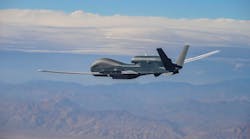Surveillance is no longer one of the functions of manned aircraft: It is increasingly being handled by unmanned aerial vehicles (UAVs), even in crowded and contested airspace, such as the western Mediterranean area. UAVs such as the RQ-4 Global Hawk and its evolutionary drone, the RQ-4D Phoenix, both developed by Northrop Grumman for NATO, are quite capable of providing high-altitude intelligence, surveillance, and reconnaissance (ISR) functions. But they must operate with clearance from NATO member countries. Part of that clearance requires extensive testing and training for drone operators and the RQ-4D recently completed more than nine hours of such exercises under the first-time control of remote NATO Alliance Ground Surveillance Force (NAGSF) trained pilots.
This first of five RQ-4D Alliance Ground Surveillance (AGS) drones was provided to NATO at the Sigonella Naval Air Station near Sicily, Italy in November 2019; the second AGS drone was shipped one month later. NATO is expecting the remaining three RQ-4D UAVs later this year. Because of the heavily populated areas and crowded airspaces in which these drones will be used, testing is critical and the NAGSF-trained pilots recently completed nine hours of training and a test flight per System Level Performance Verification requirements, working closely with the UAVs’ developers.
“Northrop Grumman is proud to support NAGSF pilots training as they control flights with number one NATO RQ-4D Phoenix,” said Jane Bishop, vice-president and general manager for autonomous systems at Northrop Grumman. “We remain committed in our relationship to NATO and the mission to protect and defend global security.” The RQ-4D (see figure) is a modified version of the Global Hawk UAV that has been adapted to NATO requirements for ISR, including protecting ground troops, civilian populations, and international borders during peacetime and wartime and helping to provide assistance during natural disasters.
